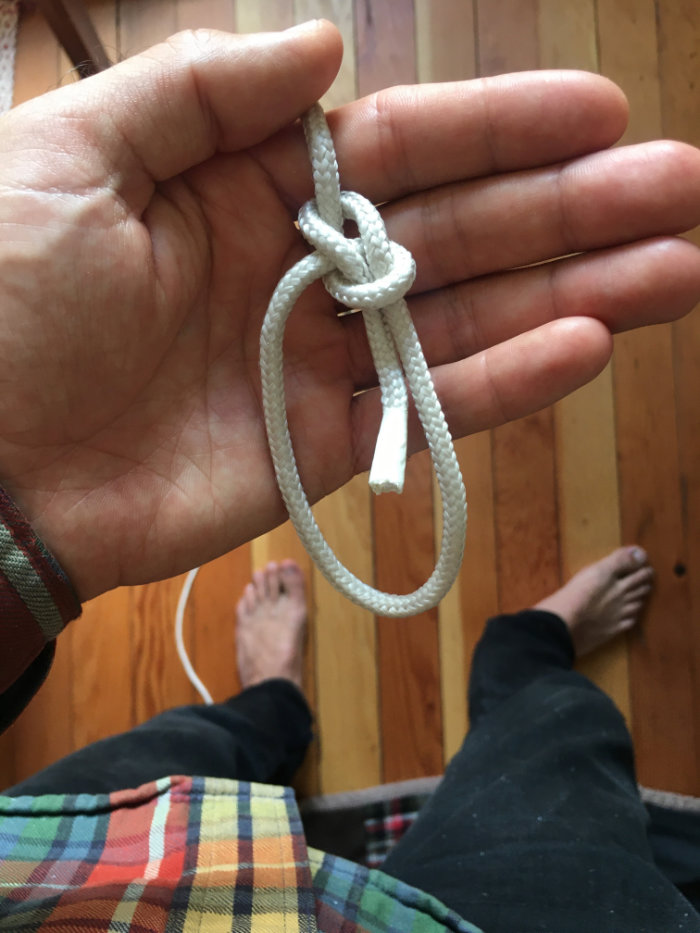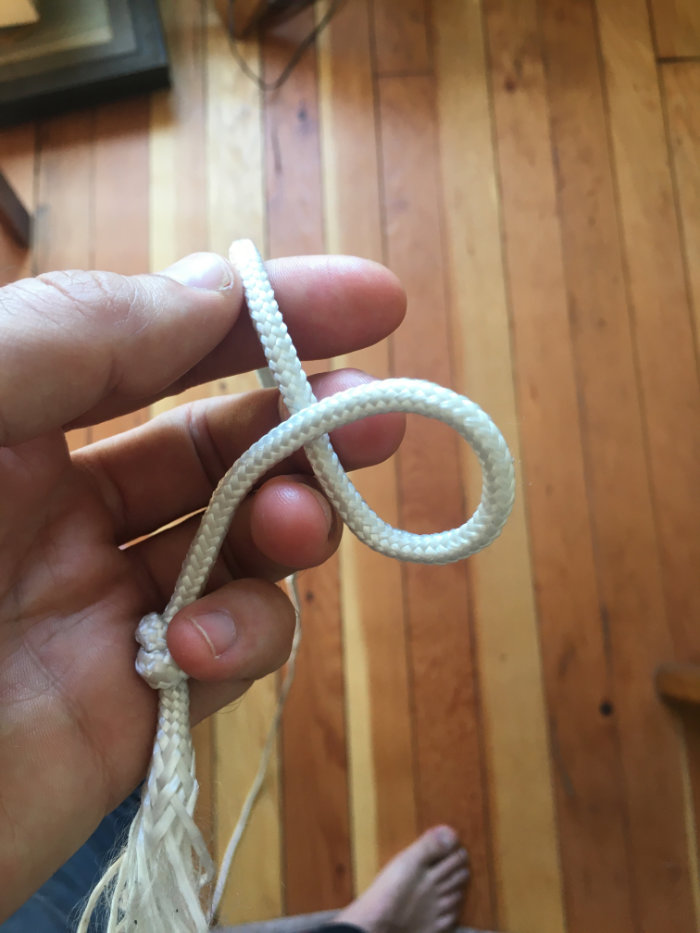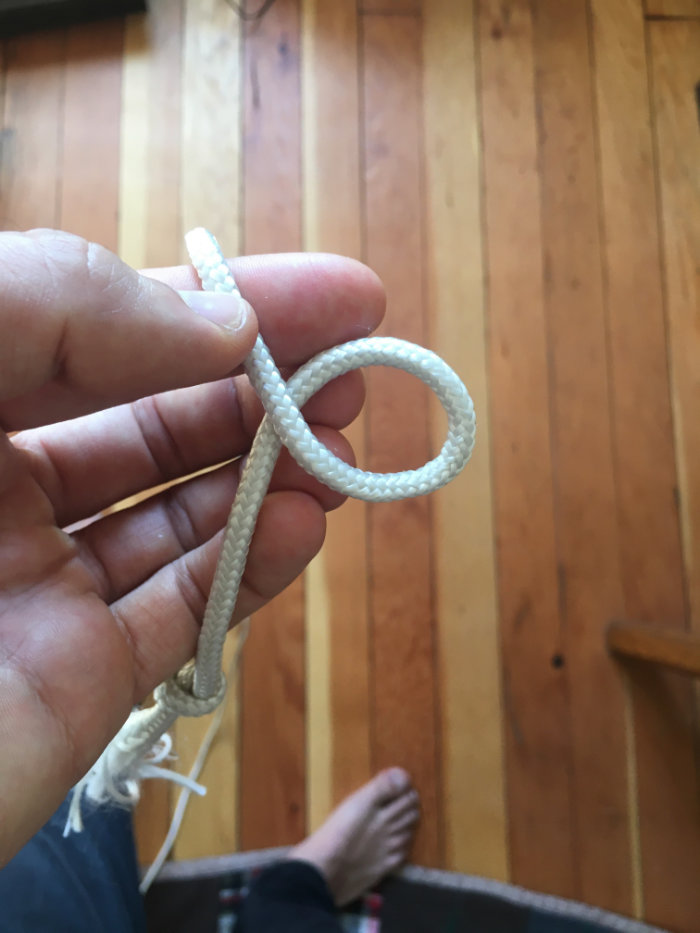Knot tying
TL;DR: The Bowline and the Trucker's Hitch are going to do 90% of what you need to do in the world. Learn the component parts rather than viewing it as a single mess of rope.
This is a guide for the absolute beginner who wants a small repertoire of very useful knots.
Learn these two, in this order:
Bowline
Besides how to tie your shoes (a Short-End Sheet Bend), this is the most important knot to know.

Uses
- Forms a loop so you can tie it around a post or tree.
- It is very, very strong so you can trust it with your life as you hang over a ravine. (Note that there are variations that are more secure and you have to be quite confident that you’ve done a proper bowline before it would make much sense to trust it with your life, plus this sentence is for entertainment purposes only. That said, I have trusted my life with a bowline)
- Even after you put a lot of force on it, such as if you are towing a car out of a ditch, you can still take it apart easily
- Possible to tie with one hand.
- You can use interlocking bowlines to tie two ropes together
- You can use as part of the Trucker’s Hitch (the second knot we’ll learn)
Instructions
Wikipedia has good instructions: https://en.wikipedia.org/wiki/Bowline
Component parts
Knots are often made up of simple components that used in many knots. For example, you’ll notice that when you tie a Bowline, you start with what the Scouts call an “Overhand Loop”:

For contrast, here I am showing an under-hand loop:

Here is an explanation of the two: https://scoutpioneering.com/2013/02/11/knot-tying-terminology/
Note: Confusingly there’s also a full knot that’s known as an Overhand Loop. In this guide, I’m talking about it in the way the Scouts are talking about it.
You’ll use multiple Overhand Loops in the Trucker’s Hitch, the second knot we’ll learn.
A principle of efficient learning is to realize what the building blocks are that apply widely. In this case it also helps with memorizing. Instead of the knot being a whole bunch of random maneuvers, it has recognizable components that are in many knots.
Rabbit story
Another way to remember things is with story. You can remember the Bowline this way: The rabbit comes up through the hole, goes around the tree and back into the hole. The hole is your Overhand Loop.
How to practice
After you’ve tied it a few times, practice by actually tying the loop around something. If you just practice it without simulating how it would be used, you may get lost when you try to actually use this knot.
Trucker’s hitch
Uses
- Tying down loads such as a canoe to your roof rack
- Any situation where you need tension and don’t have a ratchet strap handy. It’s possible to get lots of tension because of mechanical advantage. It works like a pulley system. You can tie it so tight that you can easily break things with this knot without realizing it because your force is being multiplied.
Instructions
This is considered a “compound knot”. It looks very complicated when tied, but when looked at as a number of components, it’s not hard to remember.
The Trucker’s Hitch is not a specific knot, but a way of combining various knots into a system. It combines a number of different knots and you can substitute various individual knots for each of the parts. This explains why if you look up pictures of this knot you’ll see a lot of variation.
We’ll just stick to learning one way of doing it for now. You’ll probably never need to learn any variations.
Start with this video: https://www.youtube.com/watch?v=W86XNUmElP4
This page has good instructions that break it down: https://www.netknots.com/rope_knots/truckers-hitch
Pay attention to the component parts. You’ll notice that there’s an Overhand Loop included in the part that they are calling a Slippery Half Hitch, which in itself is a common knot component. So we have components, built on components, built on components.
Here is a great technique if you are having a hard time keeping enough tension: https://www.youtube.com/watch?v=oNsuvZOI-0U
Practice
Practice the Trucker's Hitch in a situation where you are actually trying to create tension. For example, tie it between two legs of a table. Tie it so tight that you can pluck it like a guitar string. You might accidentally break your table, which would be an impressive showing for the power of the Trucker's Hitch.
How to memorize
- Spaced repetition. Do a bunch of practice sessions with time in between. Even after you know them solidly, you’ll probably have to practice every now and again if you aren’t using them much as you go through your life. It won’t take much to refresh your memory though.
- Just keep a cord by your desk or couch or wherever you normally sit in your house. Practicing Bowlines is perfect procrastination.
- Use them for their actual purpose.
The easiest way is to join Sharpen the Saw and practice every day with us.
